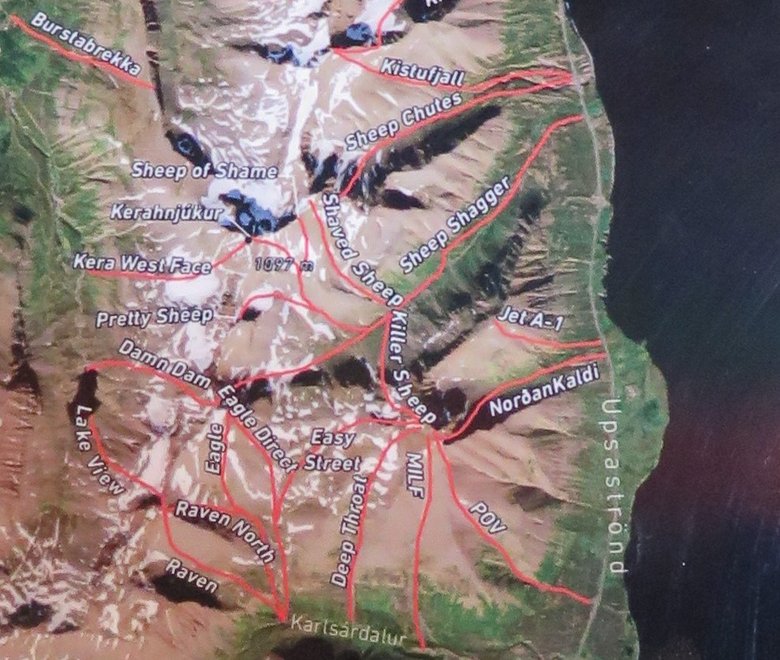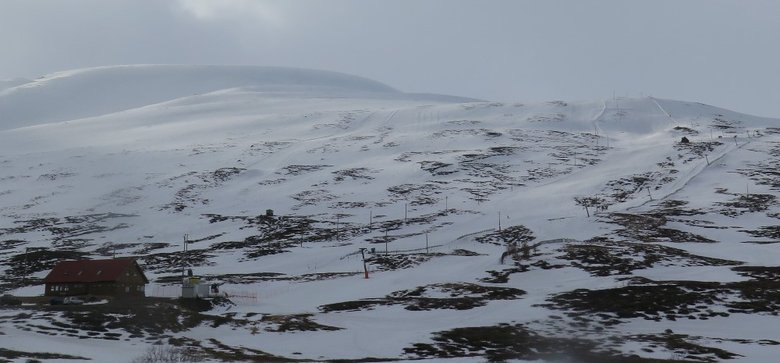Arctic Heliskiing, Iceland, March 26, 2015
After 10 days of Iceland weather I was not that optimistic about our time with Arctic Heliskiing March 25-28. There had been
a deluge of overnight rain that washed away much of the snow in Myvatn where we stayed March 20-21. Despite new snow March 23
conditions were less than ideal at the lift-served Hlidarfjall area March 24. But after a down day March 25 with drizzle and
occasional sleet at the lodge we had excellent skiing on March 26, by far our best day of the season. Yes, it’s the heli, but
it doesn’t always turn out that way as evidenced by our time in Alaska last season.
Alaska is in many but not all ways the closest analogy to Iceland heliskiing. The mountains are treeless and offer big
vertical runs. Terrain is less consistently steep but that offers more flexibility to ski the best snow most of the time.
It’s very difficult to ski in bad light at this latitude, but Iceland’s weather is highly variable (the locals say if you
don’t like the weather, wait 15 minutes) so multiday shutdowns are rarer than in Alaska. Terrain is vast, so often one sector
will have good weather for flying while others are socked in. Arctic found good skiing on March 24 while we struggled with the
flat light at Hlidarfjall. A 4-day package at Arctic includes the same 4 hours of heli flight time as a one week package at
Points North in Alaska, so that says something about relative weather prospects. Customers are picked up at Akureyri airport,
which is in the north of Iceland, a short flight or 4+ hour drive from the capital Reykvavik in the southwest. Ski terrain is
mostly on the Troll Peninsula northwest of Akureyri.
Arctic owner Jokull Bergmenn (JB) guided our group March 26, along with New Yorker Jamie and his 16-year-old son Michael.
This was their first skiing this year, though Jamie had skied 4 times with CMH between 1989 and 1993 and Michael is a high
school wrestler in excellent shape. Arctic is based in a valley south of Dalvik at the family sheep farm where JB grew up. We
first flew down the valley past Dalvik.
Our landings this first day were generally between 4,000 and 4,500 feet. Temperature on top was -7C. There was sometimes
wind up high but not much once we skied down a bit. Partway down the first run JB stopped to dig a pit. There had been 30-40cm
new snow since the big rain March 21. There was some wind effect near the landings, but typically we would ski into more
sheltered areas where softer powder had been deposited. JB and Liz partway down our first run.
Liz near our tracks farther down:
Around 2,000 feet the snow got heavier so I made more forceful turns to carve through it. But then it turned to rain
crust and I took off like an unguided missile and eventually crashed. So I was forewarned for future runs to slow down as I
approached lower elevations.
JB on our second run:
The terrain flattened near the landings, so the rain crust could be traversed with little difficulty.
Heli pickups need to be flat so it is not uncommon to have some variable snow at the bottom of runs. But here it was
only 15% or so of a 2,500 vertical run. And some of the later runs had pickups above the rain line so nearly all of the skiing
was in powder.
Here is Liz below the top of our third run, with the heli dropping the other group above.
More from third run:
The first 3 runs were south facing but the sun is not yet strong enough to affect the snow, and of course the visibility
is better. Our fourth run dropped off the north side of where we had been skiing before:
JB and Jamie
Fifth run:
At the top of the 6th run we were met by some snowmobilers.
We posed for the view of Hrisey Island in the Eyjafyordur.
Arctic will also ski in the mountains across the fjord above Grenevik if weather is good there but not on the Troll
Peninsula.
This was a long run down to lunch. Here JB puts tracks down the smooth center of a gully.
Here JB directs the heli to our lunch spot.
The other group on the long runout to lunch:
We ate lunch between 1 and 2PM, having already skied over 16K vertical since our 10AM start. Michael wondered if we could
stay out as long as daylight lasted, which is about 8PM, though my guess at this time of year (based upon my first time in
Alaska) would have been more like 6PM.
Our first run after lunch, Killer Sheep, had perhaps the best snow of the day.
Lamb is the primary agricultural product of Iceland, so many runs in this area have a sheep theme.

Here’s our 8th run, and it’s starting to get overcast.
The 9th and 10th runs were still good, but JB decided to call it a day at 4PM as the light was getting flatter and
posed a particular challenge for our last pickup in the rain crust.
We flew out from the lodge, but the other group flew back while we were picked up in a van near Dalvik. Dalvik has its
own ski area with 2 surface lifts.

We finished the day with 24,100 vertical, about 2/3 of that in powder. This was new ground for Liz, more skiing than both
days combined at Points North and 3x the vertical of her snowcat day at Wild Horse in 2013. I remarked that it was my 4th
highest heli day out of 28 lifetime, and JB responded that often they ski much more. If snow is good to low elevation the runs
can be 3,500 – 4,000 vertical instead of the 2,500 vertical runs we were skiing to stay in the best snow.
Later in the season there is a recurring group from Stowe.
They have skied as much as 82,000 vertical in a day.